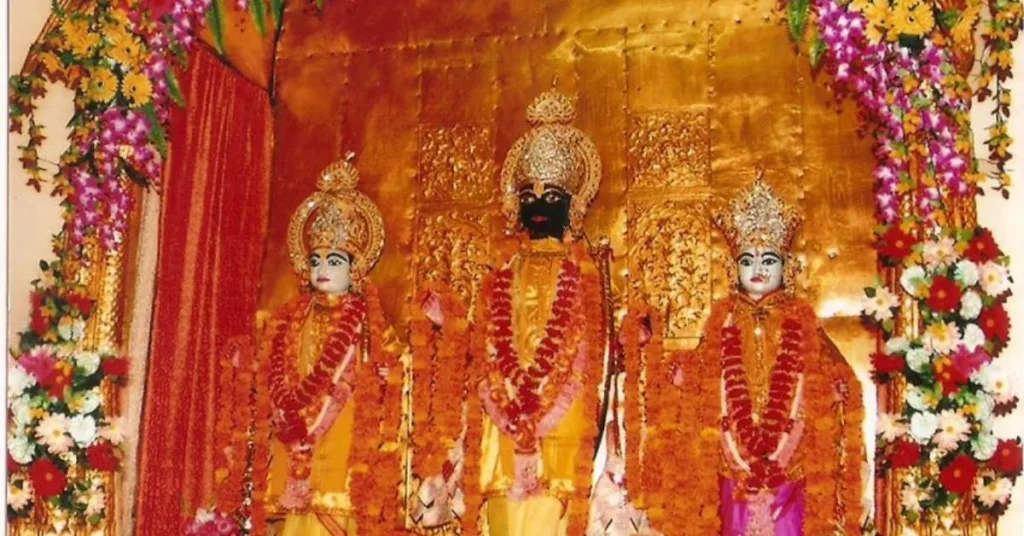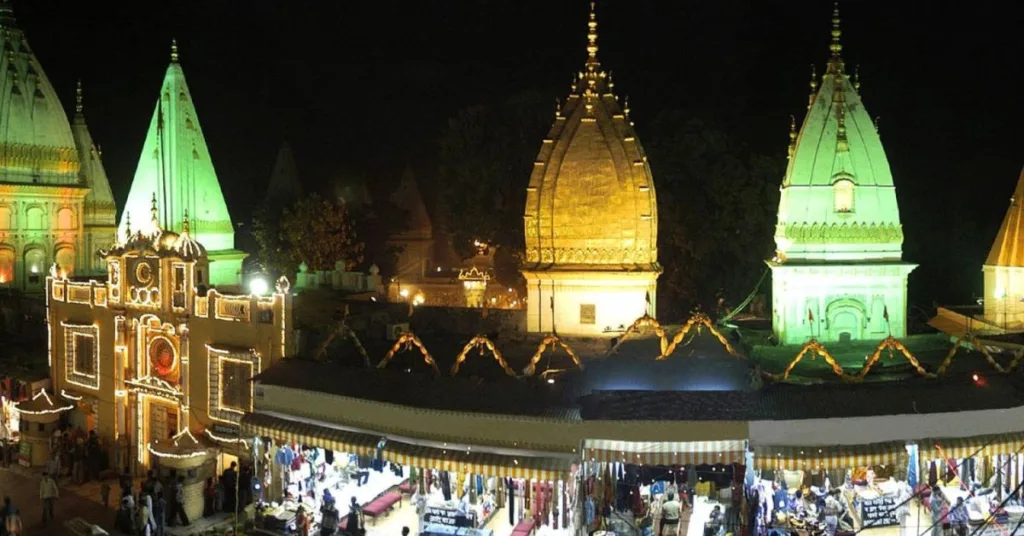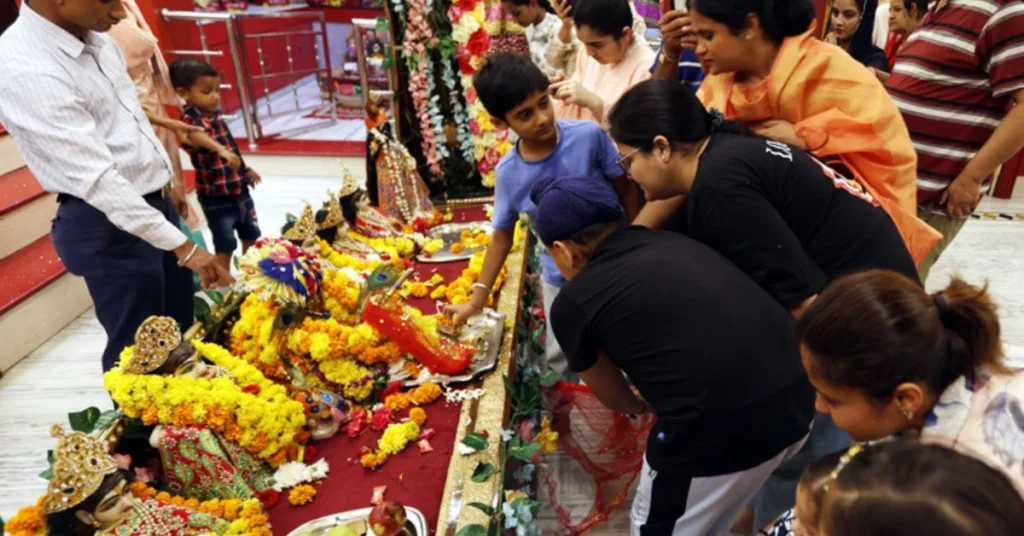Raghunath Temple Jammu, located in the heart of Jammu, is a stunning temple complex dedicated to Lord Rama. It’s one of the biggest temples in North India and a popular pilgrimage site for Hindus from around the world. Built in the 1800s by the Maharaja Gulab Singh and his son, the temple has seven shrines, each beautifully decorated with carvings, spires, and colorful paintings that tell stories from Hindu mythology.
Beyond being a place of worship, Raghunath Temple represents Jammu’s rich culture. People from all backgrounds visit to find peace, learn about history, and experience the region’s traditions. Stepping into this sacred place feels like entering a world where history, spirituality, and art come together. Whether you’re a religious person or just a traveler interested in culture, Raghunath Temple is a must-see that will leave you amazed.
How to reach:
By Air: The closest airport is Jammu Airport, about 8 kilometers away. You can take a taxi or auto-rickshaw from the airport to the temple.
By Train: Jammu Tawi Railway Station is about 5 kilometers away. From here, you can hire a taxi or auto-rickshaw to reach the temple.
By Road: Jammu has good road connections to other cities. You can take a bus, car, or taxi from cities like Srinagar, Amritsar, Chandigarh, or Delhi. The Jammu General Bus Stand is about 2 kilometers from the temple.
By Local Transport: Once in Jammu, you can easily find taxis, auto-rickshaws, or cycle-rickshaws to get to Raghunath Temple. It’s located in Raghunath Bazar, a well-known area.
Best time to visit:
1. Winter (October to March):
- Weather: Cool and comfortable with temperatures between 5°C and 20°C.
- Why Visit: Ideal for sightseeing and outdoor activities. Clear skies and crisp air make it perfect for exploring the temple. Enjoy the festival of Diwali in October or November.
2. Summer (April to June):
- Weather: Hot with temperatures reaching 40°C. Mornings and evenings are cooler.
- Why Visit: Fewer crowds, offering a more peaceful experience. Ideal for early morning or late evening visits.
3. Monsoon (July to September):
- Weather: Moderate to heavy rainfall with temperatures between 25°C and 35°C.
- Why Visit: Refreshing weather and lush greenery. However, occasional waterlogging and slippery roads may make travel challenging. Great for travelers seeking a quieter experience.
Attractions:
Main Sanctum of Lord Rama:

The heart of Raghunath Temple is the main sanctum, dedicated to Lord Rama. As you enter, you’ll see beautiful statues of Lord Rama, his wife Sita, and his brother Lakshmana. They’re all dressed in colorful clothes and wearing lots of jewelry. The sanctum is decorated with gold and marble, making it look very grand and peaceful. It’s a perfect place to pray, meditate, or just think. There are also smaller statues of other gods, showing how Hinduism includes many different beliefs.
The walls are painted with pictures from the Ramayana, a story about Lord Rama. These pictures show important events in his life, like his birth, exile, battles, and victory over the evil king Ravana.
Seven Shrines Complex:
Raghunath Temple is famous for its beautiful architecture. It has seven different shrines, each dedicated to a different Hindu god or goddess. These shrines represent the many different aspects of Hindu spirituality.
Besides the main shrine for Lord Rama, there are shrines for Lord Vishnu, Lord Shiva, Goddess Durga, Lord Ganesha, and other important Hindu gods. Each shrine is a masterpiece of architecture, with its own unique style. They’re decorated with beautiful carvings, colorful paintings, and other ornaments that show the beauty of the divine.

Daily Aarti and Bhajan Ceremonies:

Raghunath Temple is renowned for its stunning architecture. The temple complex houses seven separate shrines, each dedicated to a different Hindu deity, representing various facets of Hindu spirituality.
In addition to the central shrine dedicated to Lord Rama, the temple complex includes shrines devoted to Lord Vishnu, Lord Shiva, Goddess Durga, Lord Ganesha, and other significant deities of the Hindu pantheon. Each shrine is a masterpiece of architectural design, showcasing unique styles and intricate details.
Local Experiences:
Raghunath Bazar:
- Wander through the bustling market to shop for traditional crafts like Kashmiri handicrafts, Pashmina shawls, and local jewelry.
- Sample delicious local sweets and snacks at the various eateries.
Aarti Ceremonies:
- Attend the daily morning and evening aarti ceremonies to witness vibrant rituals, listen to devotional songs, and experience the spiritual atmosphere.
Local Cuisine:
- Try authentic local dishes like Rogan Josh, Rajma Chawal, Kaladi Kulcha, and traditional sweets at nearby restaurants and street food stalls.
Souvenirs:
- Shop for unique souvenirs like Kashmiri carpets, saffron, dry fruits, and handcrafted items that reflect the region’s culture.
Historical Architecture:
- Discover the architectural marvels within the temple complex, including intricate carvings, frescoes, and the seven distinct shrines.
Local Festivals:
- Time your visit to coincide with major Hindu festivals like Diwali, Navratri, Ram Navami, and Janmashtami.
Nearby Temples:
- Explore other significant temples in Jammu, such as Ranbireshwar Temple, Vaishno Devi Temple, and surrounding shrines.
Interacting with Locals:
- Engage with friendly shopkeepers, artisans, and locals to learn more about their traditions, customs, and everyday life.
Scenic Views:
- Enjoy the scenic views of the city and nearby hills while strolling around the temple.
Sacred Libraries:
- Explore the sacred libraries within the temple complex to view ancient manuscripts, rare books, and religious texts.
Travel tips:
- Dress Modestly: Cover your shoulders and knees.
- Remove Shoes: Leave your shoes in designated areas outside the temple.
- Timing: Visit early in the morning or late in the evening to avoid crowds and experience aarti ceremonies.
- Cash: Carry cash for small purchases and offerings.
- Respect Customs: Avoid touching or photographing sacred idols and areas.
- Hydration: Carry water, especially in warmer months.
- Transportation: Arrange for local transport in advance or use reliable taxi services.
- Pickpockets: Be cautious in crowded areas like Raghunath Bazar.
- Photography: Check for any restrictions on photography.
- Local Cuisine: Sample local cuisine at reputable eateries.
- Weather: Check the weather forecast and dress accordingly.
- Health: Plan ahead for any health concerns or dietary restrictions.
- Respect: Maintain a respectful demeanor inside the temple.
Conclusion
Immerse yourself in the rich tapestry of experiences offered by Raghunath Temple in Jammu on Xplro.com, your one-stop travel guide. This iconic landmark transcends religion, serving as a cultural and historical treasure trove. Witness majestic architecture, intricate carvings, and vibrant ceremonies, providing a profound glimpse into Hinduism’s spiritual and artistic heritage. The main sanctum, adorned with beautiful idols and a serene ambiance, is the heart of the complex. Seven surrounding shrines and sacred libraries offer further depth and diversity. Bustling Raghunath Bazar adds a vibrant touch, inviting you to engage with local culture, cuisine, and crafts. Whether seeking the spiritual allure of aarti ceremonies, the cultural richness of art, or the lively spirit of festivals, Raghunath Temple promises a memorable journey. By following local customs, planning your visit, and embracing the experiences, you’ll fully appreciate this significant and beautiful temple. Deepen your understanding of Hindu traditions and immerse yourself in Jammu & Kashmir’s unique culture – Raghunath Temple is an unforgettable destination for all.
FAqs
What is the significance of Raghunath Temple?
- Raghunath Temple is renowned for being a major spiritual site in Northern India, dedicated mainly to Lord Rama. The temple complex is noted for its impressive architecture, detailed carvings, and the unique presence of seven individual shrines. It is also celebrated for its lively aarti ceremonies and its deep cultural importance.
Where is Raghunath Temple situated?
- Raghunath Temple is located in Jammu, a city in the Union Territory of Jammu & Kashmir, India. It is centrally positioned in Jammu, making it easily accessible from various parts of the city.
When is the best time to visit Raghunath Temple?
- The ideal time to visit Raghunath Temple is from October to March when the weather is cooler and more comfortable. This season is preferable to avoid the intense heat of summer and the heavy rains of the monsoon season.
Are there any dress code guidelines for visiting the temple?
- Yes, visitors are asked to dress modestly when entering the temple. Clothing should cover the shoulders and knees as a mark of respect. It is best to avoid wearing revealing or inappropriate attire.
Can I take photographs inside the temple?
- Photography inside the temple is generally not permitted, particularly near the main sanctum and sacred idols. It’s advisable to check the specific rules on photography at the temple and adhere to them out of respect for the worship practices.
What are the times for the aarti ceremonies?
- Aarti ceremonies are typically conducted twice a day—once in the morning and once in the evening. The exact timings may vary, so it’s a good idea to confirm the schedule locally or at the temple before your visit.
How can I get to Raghunath Temple from Jammu Railway Station?
- Raghunath Temple is approximately 3 kilometers from Jammu Railway Station. You can take a taxi, auto-rickshaw, or local bus to reach the temple, which usually takes about 10-15 minutes depending on traffic conditions.
What facilities are available for pilgrims at the temple?
- Raghunath Temple provides basic amenities for pilgrims, including drinking water and restrooms. There are also designated areas for leaving footwear and making donations.
What should I be aware of before visiting the temple?
- Be mindful of the temple’s dress code, footwear policies, and any restrictions on photography. It’s also helpful to bring cash for offerings and purchases, and to be respectful of local customs. The temple can be crowded, particularly during festivals.
Are there other attractions to see near Raghunath Temple?
- Yes, there are several nearby attractions, including Ranbireshwar Temple, Vaishno Devi Temple, Mubarak Mandi Palace, and Raghunath Bazar. These sites offer additional cultural and historical experiences in Jammu.
Can I purchase souvenirs around Raghunath Temple?
- Yes, you can find various souvenirs such as Kashmiri handicrafts, Pashmina shawls, and local jewelry at Raghunath Bazar, located adjacent to the temple. The bazar also offers local food and snacks.
Is there an entry fee to visit Raghunath Temple?
- There is no entry fee for visiting Raghunath Temple. However, donations are appreciated, and there may be small charges for offerings or specific services within the temple.






